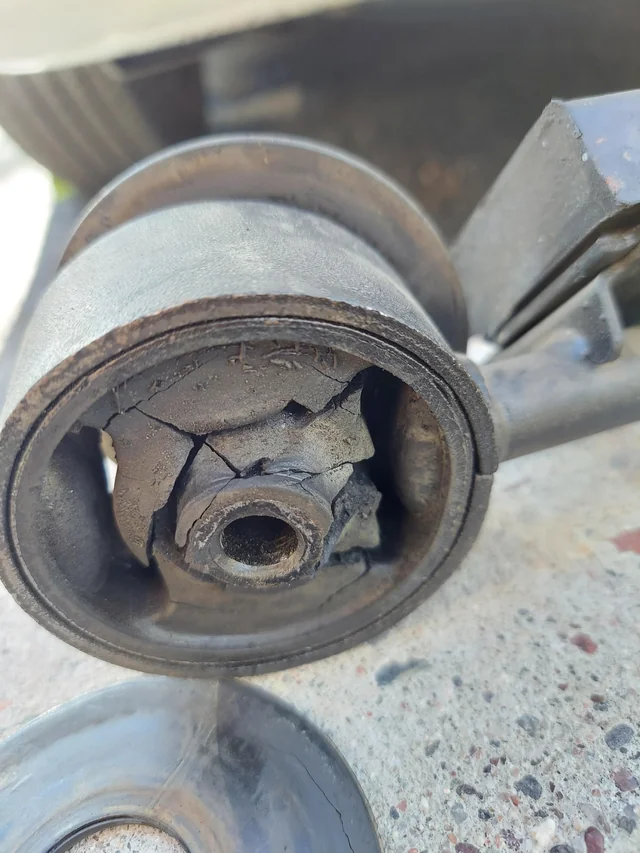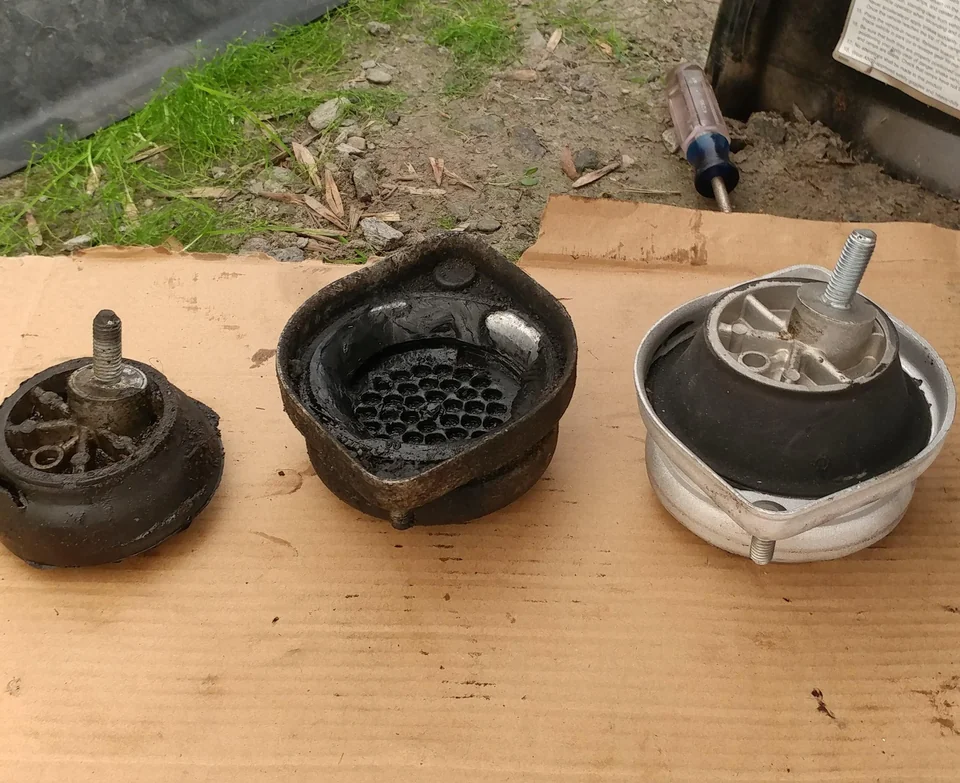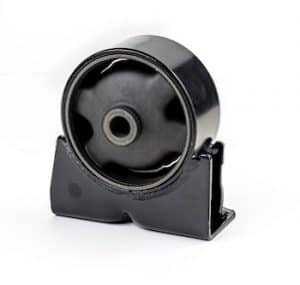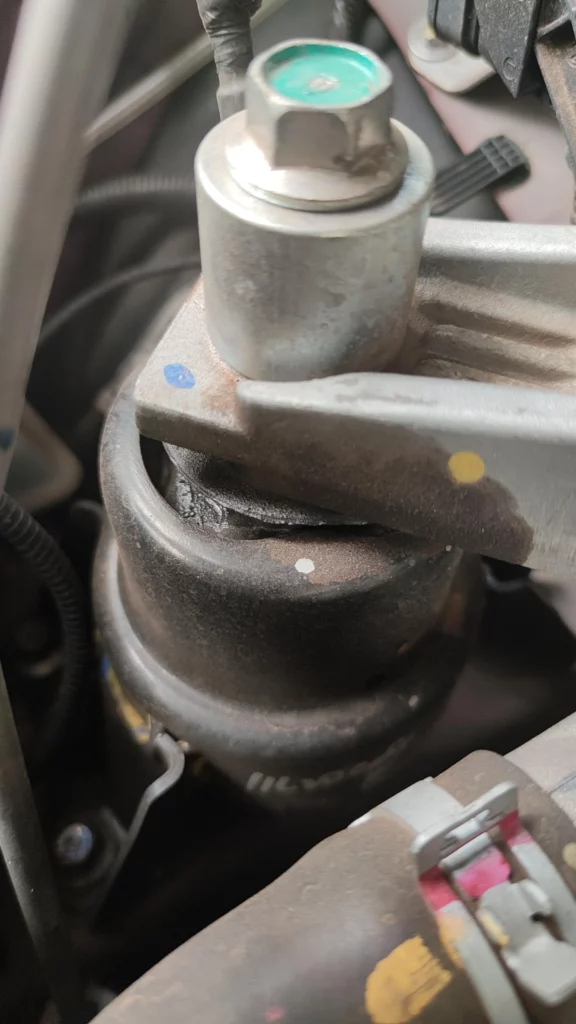Motor mounts can prevent engine movement during driving. They support the entire engine absorbing by vibration. Motor mounts are important because they support and isolate the entire engine. Once the motor mount doesn’t work well, it can affect the safety and performance of your vehicle.
Apart from the question is, can you drive with bad motor mounts? Today we will discuss motor mounts in every aspect. Let’s deeply dig into the article.
Table of Contents
Can You Drive With Bad Motor Mounts?
You should not be driving with bad motor mounts as it can cause significant damage to your vehicle and may also be dangerous. It is recommended to have the motor mounts replaced as soon as possible to prevent further damage.
Motor Mounts: How Do They Work?
The working mechanism of a motor mount is simple. It has one end secured with bolts, whereas the other end finds its way to the vehicle frame. Their basic role involves the isolation of the surrounding steel plates from the source of the vibrations. In other words, we can infer that it functions by acting as a barrier to the steel, which is in close contact with the area of maximum vibrations.
So, when the engine vibrates, the surrounding steel is kept at bay by the mount. However, it does not restrict any movement of the components. Instead, it allows a simultaneous movement while holding the same components together and distancing them from the engine.
The hydraulic mounts achieve the same purpose with the help of fluids. In contrast, the most commonly used rubber mounts hold the metal components while allowing a slight movement simultaneously. All of it is in addition to absorbing the vibrations and preventing them from damaging other parts.

Motor Mounts: Different Types
You can find engine mounts of various designs according to their application. Different designs are available depending on the energy amount they need to absorb. Most engine mounts available out there are relatively small. These serve the purpose of only dampening and absorbing the energy without taking up too much space. The engine mount or the motor mount consists of a few parts.
One of those includes the molded rubber brushing, which is a major component that plays the role of a cushion. As a cushion, it helps control the vibration that the engine generates.
Because of its utility, the manufacturers attach it directly to the engine. They secure it with the help of a bolt that goes through the motor mount’s length. The main objective of the rubber brushing is to provide a rubber break between the two mating surfaces.
Some manufacturers provide a metal cover to attain more stability on the rubber part. You can find engine mounts in various shapes. They can come as large or, in other cases, with multiple mounts that connect to a frame.
It is the part that holds the engine in your car. In most cars, we can find an engine and transmission together. Three or four-engine mounts hold them together, avoiding any chance of slippage. So, the mount holding the transmission in place is known as the transmission mount, whereas the others are called engine mounts or motor mounts.
The mounts become essential because an engine is the source of most vibrations in a car. As a result, it involves various rotating and moving parts while in operation. These vibrations can grow intense depending on the engine’s power and your usage. Hence, they need to be damped at the right time. If they are left uncontrollably, damage to other sensitive parts may occur.
So, the need for mounts in an engine is significant as mounts hold the engine and absorb the extra vibrations and reduce the chance of damage. Usually, they are made with a rubber material as rubber acts as an excellent vibration absorber. However, many manufacturers sometimes prefer different materials for the mounts.
You can sometimes find a different type of mount altogether; for example, we can see Porsche using electromagnetic mounts in their high-performance cars. The electromagnetic mounts work on the electromagnetic forces that can actively reduce the vibrations that an engine dissipates throughout the body.
On the contrary, manufacturers such as Toyota, Honda, etc., incorporate a vacuum-based mount for their car engines. They employ active vacuums to control and provide the dampening effectively.
For efficient dampening, manufacturers also use a liquid that fills the engine mount, other than using a rubber brushing, vacuum, electromagnets, etc. It also acts as a shock absorber.
You can find such mounts made with hydraulic fluid on the inside. The ones made with hydraulic fluid provide an increased stability and damping function. However, the shape, materials, size, etc., of the engine mount depends on its expected load.
These features may change depending on how much load is applied to the mount. Moreover, they can also vary as per the energy the mount absorbs or dampens because of the transmitting. Therefore, you need not provide frequent servicing, like other parts of your car may require. However, you might need to replace the mounts depending on their usage. It is always advisable to replace the mounts once they wear out or show failure symptoms.

Solid Rubber Motor Mounts
As the name suggests, solid rubber motor mounts or transmission mounts utilize a solid rubber cushion. You can usually find the rubber motor mounts specifically bolted to the engine transmission and chassis. It involves the use of steel-backed plates. Such a combination enables the rubber mounts to have flexibility and movement. It also reduces the shocks that the system experiences. As a result, it expands the life span of the vehicle’s components. We can find solid rubber motor mounts typically in trucks and cars.
It is a robust engine mount that efficiently holds the engine in the same place. It helps absorb the vibrations, but it also helps reduce the overall noise that the engine generates. Compared to other types, the distinguishing feature is that it’s available at a low cost.
The durability of the rubber motor mounts depends on the rubber’s quality the manufacturer uses. However, the mounts can develop cracks and tears with time, especially if you use them under a heavy load.
Hydraulic Motor Mounts
Hydraulic motor mounts are otherwise known as hydro motor mounts. They are named because they are filled with a hydraulic fluid gel or liquid.
The design of the hydraulic motor mounts allows them to absorb the potentially harmful vibrations before they even reach the chassis. Their primary application is with the motors producing a lot of low and high-frequency vibrations. Since they effectively deal with both the extremes of vibration, they are particularly preferable in vehicles and industries. It is because they require the noise level to be low.
We can find this type of mount commonly in the industries that include automotive applications, constructions, marine applications, etc.
The main reason behind their preference is their better performance under a range of conditions where the traditional rubber mounts may fail. However, you can select the rubber mounts for comparatively narrower conditions.
Hydraulic motor mounts have a higher production cost because of their components. Therefore, they are more expensive than the usual rubber mounts. Also, since it uses hydraulic fluid, there is a chance of fluid leakage and collapse when used exhaustively. So, you must be careful to avoid extensive usage to prevent that. You can prevent such a scenario by correctly assessing the conditions of the mount.
Metal Motor Mounts
Metal motor mounts are another type of engine mount that effectively prevents vibrational damage to the engine.
It helps by creating a strong and secure connection between the chassis and the engine. As a result, it enables the transfer of a huge amount of power to the wheels. Since it nullifies the vibrations just like other mounts do, the wheels stay rigid, even when you subject it to a heavy load.
But one should note that since it involves a metal-to-metal connection, it transmits noise, unlike other variants of engine mounts.
Electronic (Active) Motor Mounts
The Electronic engine mounts utilize a design that varies the mount’s damping characteristics and stiffness. Consequently, it helps in reducing the vibration and noises depending on the load the vehicle is subjected to.
It uses a control system that uses various sensors, where the vehicle data is fed after being monitored. It may use various methods in the control system to minimize vibrations. Common methods include the vacuum actuator or a counter shake mechanism.
Polyurethane (Pu) Motor Mounts
The rubber mounts offer a drawback in their durability as they may not last for longer periods. Therefore, we can find a much more durable and longer-lasting substitute in the form of PU motor mounts. Instead of natural rubber or isoprene, the PU motor mounts offer to last longer because they use polyurethane as the material.
It is a substance that provides a longer life along with the same benefits that natural rubber can provide. Therefore, the PU mounts will offer you the same benefits as a solid steel engine mount.
With the help of such properties, the engine’s performance can enhance significantly. So, you can get a better feel of the road when the vibrations are nullified. However, their increased utility and material difference are costlier than the usual rubber mounts.
Moreover, a drawback of this type of mount is that it is less resilient towards heat, unlike the solid rubber mount.
Therefore, it can sometimes cause troubles in the automotive application. PU bonding to the metal surface is also more difficult to attain than natural rubber.
Motor Mount: Causes and Effects
The failure of an engine or motor mount depends on various reasons. One of the major causes is mechanical fatigue. Fatigue signifies the inability to perform the same task due to overexertion. Any mechanical body that experiences any force is susceptible to mechanical fatigue. So, the mounts are no different and are not exempted from it.
We know that the mount is situated near the engine, and every time we start the engine, it has to experience vibrations. Each combustion cycle that takes place inside every cylinder would create some vibration. The vibration dissipates from the engine to the motor mount every time we ignite it.
It is a part of the mechanics of the car, as every time the engine generates force, the crankshaft receives it and then transmits it to the drivetrain and, eventually, the wheels. Therefore, the mount is in a continuous function of contacting these forces. As a result, these actions can cause an over-exhaustion of the rubber and metal, leading to fatigue.
The location of most mounts is deep inside the engine bay. They may contact leaking fluids.
The rubber may be exposed to higher ozone levels in the same environment. Ozone may form as a result of various combustive reactions taking place. It is a natural foe to rubber, as it disturbs the chemical composition of the natural rubber.
Engine mount failure may also result from the control system’s dysfunction.
The system’s main function is to control the stiffness of the mount. It achieves the purpose with the help of engine vacuum or electric valves. So, if the electronic control system is dead due to technical issues, the engine movement can go out of control.
Engine mounts also tend to wear out over time if they are made of rubber or polyurethane materials. In addition to that, heat, oxygen, and ozone exposure can cause them to attain stiffness over a long usage period. It will drastically reduce their dampening efficiency.
You can identify the stiffening if you feel an increased engine vibration.
The stiffness is a harmful occurrence to the mounts. It may eventually lead the mount to crack at any moment. Also, if your engine experiences oil leaks, that will weaken the cracks further.
The cracked mounts will not function properly in absorbing the vibrations. As a result, serious issues such as intake malfunction, wiring damage, etc., can arise.
If the engine mount breaks as the crack weaken further, it will
allow the engine to move more than it should. In severe scenarios, which can even lead to an engine misfire or engine failure.
A knocking or clunking sound may be audible while you accelerate. It can be a clear indication of a broken mount. You can also hear such voices while downshifting or upshifting the transmissions. Crushed oil filters, ripped radiator hoses, crushed AC compressor clutches, etc., can be some of the potential effects that may arise from a broken mount.
Diagnostics
It is important to diagnose the failed mount before it causes the engine to swing forth and back. A user may not always identify the issue and may ignore the indications most of the time. So, here we will discuss the need and ways to diagnose the engine mount failure. However, a user can always seek a mechanic for help if visible conditions such as the exhaust system and the underbody come in contact while you throttle.
The best way to diagnose an engine mount failure is when you start facing problems that are unrelated to the mount. If you fail to diagnose the issue in time, and if left unidentified, the extreme engine movement can stress the EVAP lines.
Any excess stress can stretch the electrical connectors and battery cables since the lines extend from the firewall to the intake manifold. That may lead to a situation where you are deprived of a start condition. So, such an indication would not require running any further diagnostic tests.
On the other hand, you can diagnose faults in Vacuum-powered mounts through their visible leaks. They can leak if they are damaged, causing idle problems. As a result of the leak, you possibly see lean fuel trims on some vehicles.
If you notice your vehicle having a leaking exhaust flex pipe or
a flange connector, it is time for you to inspect the transmission mounts and the engine itself.
If your mount is variable, you need to view the pulse-width modulated signal. If you want to diagnose the same for older mounts, you can use a vacuum gauge or a smoke machine. Those will be effective in spotting any occurring leaks.
Some vehicles may already have software and an OBDII connector for helping in the diagnostics.
Together they can display the three axes of vibration. It can also display the engine RPM on a computer. Therefore, such a system can also ease the diagnostics process.
Inspection
Another way of identifying the faults is by simply inspecting them. With a test drive that solely recognizes the mount faults, you can do that. You can take the help of an assistant or hire a mechanic and ask them to apply the brakes and then push the throttle gently. While they do that, you can inspect the engine bay. If you notice only some minor movements, then you can ignore them. However, if you witness large engine movements visibly stretching the hoses, it marks a damaged mount.
You can then inspect the mounts, and if you notice any visibly deep cracks on the rubber material, it’s a red signal. However, if the rubber has already separated from the metal components, driving with such an engine is dangerous until you replace the mount.
On the other hand, while inspecting, you must resolve the leak if you find the mount surrounded by fluid.
After that, you can move to install a new one.
Sign & Symptoms of Bad Motor Mounts

You will not look much from outside, because motor mounts are small parts. They’re comparatively small, but they are very much important. Why they’re remarkably important? Because they’re responsible for keeping the entire engine settled and aligned with the vehicle frame.
There are some vital signs of a bad motor mount. Else they will get worse, you will need to be addressed soon.
- Impact Noise: If the engine is vibrating or shaking around in the frame, then clanking and knocking noises will be produced. Though this noise will cause by other things too, you should check your motor mount. Always remember that the most common symptoms of bad motor mounts are impact noises.
- Excessive Vibrations: Excessive vibration is another vital symptom of a bad motor mount. If the rubber parts of the motor mount were broken out, it will reduce the absorption ability of vibration. As a result, it will cause the entire vehicle to vibrate, which makes them uncomfortable for the passengers.
- Engine Movement: Engine movement is another symptom of bad motor mounts. When the motor mounts condition is good, they will able to secure the engine firmly in the engine bay. If they’re broken anyhow, then the engine will move forward or backward in the engine bay. Maybe you will not notice this shifting, so it’s a wise decision to take your automobile to an expert.
- Engine Damage: When several motor mounts completely failed, they can result in damage to the engine. Missing support from the mounts, the engine will be free to move around, results in potential damage. The failed motor mount can put the engine at a drastic angle, and that can also affect other components.
These symptoms may differ from the extremity of mount’s damage, as well as configuration or design of the engine. In general, vibrations are more apparent in bad motor mounts. Clunking noise is another common symptom of a bad motor mount. In addition, there are other signs you need to be mindful of as well.
Results Of a Bad Motor Mount
Motor mounts will keep the entire engine and the vehicle’s structure in place. But, what happens when the motor mounts weren’t worked properly?
At first, loose mounts aren’t able to keep the frame well. As a result, the engine and transmission don’t remain in the proper place. When these two parts weren’t in place, they will strike with other components.
The entire situation puts stress on the movement. Additionally, overheating also takes place too. If you will keep this bad motor mount, it will make the situation even worse.
Furthermore, almost every part gets affected and the overall driving experience gets ruined.
Can You Drive With Bad Motor Mounts?
Initially, the bad motor mounts cause some irritating noise.
If you continue with this for a long time, it creates a big problem.
Always remember that you can drive with bad motor mounts but not for long. Continuous driving with bad motor mounts will make your vehicles unsafe. So, an wise decision is replacing the bad motor mount as early as possible. This action will save you from more costly repairs in the long run. Additionally, it also helps to remain your vehicle safe.
So, can you drive with bad motor mounts? The absolute answer is, Yes, you can drive with bad motor mounts but not for long.
Whereas you continue with bad motor mounts, it will pull through your vehicle unsafe.

Should You Replace All Motor Mounts?
In general, there are several motor mounts that keep your engine and transmission in place. But in all cases, you don’t require to replace all of them at once. When any one of your motor mounts gets busted or worn out, you can just change out this one.
However, in some cases, you have to replace all of the mounts at once as a preventative measure. Take into consideration that one mount fail means, it will put an extra strain on others. That will dominate on the other mounts to an early demise.
Although motor mounts are designed for extended service, it will not happen all time. Motor mounts will damage and exposure to the elements after years of use. As earlier as you understand these symptoms it’s become easy to spot.
Moreover, different elements can permanently damage your motor mounts in other cases. You have always put the proper attention on it. That can bring you to an enjoy a full smooth and safe drive.
Replacement Cost of Motor Mounts
For getting replacement parts, you can check Amazon.
The replacement cost of motor mounts totally depends on the brand, quantity, and fitment.
In general, the replacement cost for the motor mount differs from $220 to $570. The additional expense is parts and labor costs. This cost relatively varies from a model of your vehicles.
The cost of parts differs from $40 to $150, while the labor costs will vary from $90 to $400. It’s all depends on how tough is for the mechanic to obtain your motor mount.
In summary, the total replacement cost is around $220 to well over $1,000.
If you want to see what are the best motor mounts. Just get linked with Amazon.
Frequently Asked Questions
How much does it cost to replace motor mounts?
Replacing motor mounts typically costs between $10 and $200, depending on the vehicle make, model, and labor costs. High-performance or luxury vehicles may have higher replacement costs.
Can bad motor mount damage transmission?
Yes, bad motor mounts can damage the transmission, as excessive engine movement may strain transmission components, leading to premature wear or failure.
What happens if you don’t fix motor mounts?
Ignoring bad motor mounts can result in increased vibrations, damaged engine components, transmission issues, and unsafe driving conditions due to excessive engine movement.
Conclusion
Always remember that, whether motor mounts aren’t keeping the engine in place, it will cause difficulties and can make the vehicle risky to drive.
Take into consideration that you can drive with bad motor mounts but not for a longer period of time. Continuous driving with bad motor mounts will make your vehicles unsafe.
An intelligent decision is replacing the bad motor mount as soon as possible.
